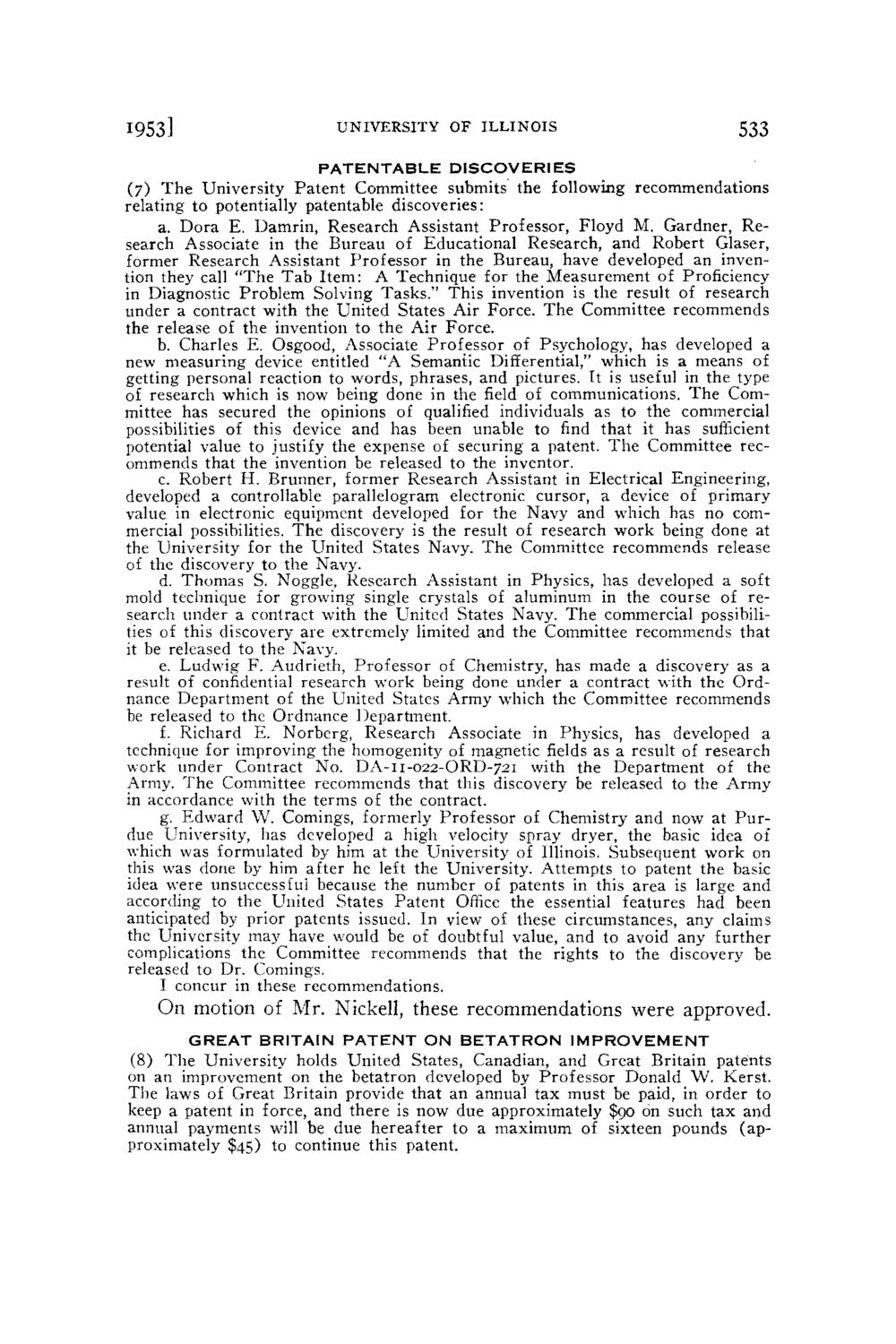| |
| |
Caption: Board of Trustees Minutes - 1954
This is a reduced-resolution page image for fast online browsing.

EXTRACTED TEXT FROM PAGE:
1953] UNIVERSITY OF ILLINOIS 533 PATENTABLE DISCOVERIES (7) T h e University Patent Committee submits the following recommendations relating to potentially patentable discoveries: a. Dora E. Damrin, Research Assistant Professor, Floyd M. Gardner, Research Associate in the Bureau of Educational Research, and Robert Glaser, former Research Assistant Professor in the Bureau, have developed an invention they call "The Tab Item: A Technique for the Measurement of Proficiency in Diagnostic Problem Solving Tasks." This invention is the result of research under a contract with the United States Air Force. The Committee recommends the release of the invention to the Air Force. b. Charles E. Osgood, Associate Professor of Psychology, has developed a new measuring device entitled "A Semantic Differential," which is a means of getting personal reaction to words, phrases, and pictures. It is useful in the type of research which is now being done in the field of communications. The Committee has secured the opinions of qualified individuals as to the commercial possibilities of this device and has been unable to find that it has sufficient potential value to justify the expense of securing a patent. The Committee recommends that the invention be released to the inventor. c. Robert H. Brunner, former Research Assistant in Electrical Engineering, developed a controllable parallelogram electronic cursor, a device of primary value in electronic equipment developed for the Navy and which has no commercial possibilities. T h e discovery is the result of research work being done at the University for the United States Navy. The Committee recommends release of the discovery to the Navy. d. Thomas S. Noggle, Research Assistant in Physics, has developed a soft mold technique for growing single crystals of aluminum in the course of research under a contract with the United States Navy. The commercial possibilities of this discovery are extremely limited and the Committee recommends that it be released to the Navy. e. Ludwig F. Audrieth, Professor of Chemistry, has made a discovery as a result of confidential research work being done under a contract with the Ordnance Department of the United States Army which the Committee recommends be released to the Ordnance Department. f. Richard E. Norbcrg, Research Associate in Physics, has developed a technique for improving the homogenity of magnetic fields as a result of research work under Contract No. DA-11-022-ORD-721 with the Department of the Army. T h e Committee recommends that this discovery be released to the Army in accordance with the terms of the contract. g. Edward W. Comings, formerly Professor of Chemistry and now at P u r due University, has developed a high velocity spray dryer, the basic idea of which was formulated by him at the University of Illinois. Subsequent work on this was done by him after he left the University. Attempts to patent the basic idea were unsuccessful because the number of patents in this area is large and according to the United States Patent Office the essential features had been anticipated by prior patents issued. In view of these circumstances, any claims the University may have would be of doubtful value, and to avoid any further complications the Committee recommends that the rights to the discovery be released to Dr. Comings. I concur in these recommendations. On motion of Mr. Nickell, these recommendations were approved. GREAT BRITAIN PATENT ON BETATRON IMPROVEMENT (8) The University holds United States, Canadian, and Great Britain patents on an improvement on the betatron developed by Professor Donald W. Kerst. The laws of Great Britain provide that an annual tax must be paid, in order to keep a patent in force, and there is now due approximately $90 on such tax and annual payments will be due hereafter to a maximum of sixteen pounds (approximately $45) to continue this patent.
| |